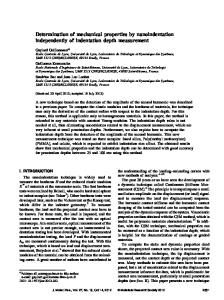Numerical study on the measurement of thin film mechanical properties by means of nanoindentation
- PDF / 319,480 Bytes
- 9 Pages / 612 x 792 pts (letter) Page_size
- 57 Downloads / 359 Views
Nanoindentation is a technique commonly used for measuring thin film mechanical properties such as hardness and stiffness. In this study, we used the finite element method to investigate the effect of substrate and pileup on hardness and stiffness measurements of thin film systems. We define a substrate effect factor and construct a map that may be useful in the interpretation of indentation measurements when it is not possible to make indentations shallow enough to avoid the influence of the substrate on the measurements. A new technique for measuring mechanical properties of thin films by nanoindentation is suggested at the end of this article.
I. INTRODUCTION
One of the most important material configurations in microelectronics, optoelectronics, and thermal barrier coating technology consists of a coating material deposited onto a substrate of another material. Proper measurement of the mechanical properties of thin films is the first step in analyzing the mechanics of thin films and multilayers. Industry has long relied on indentation techniques for measuring the hardness and stiffness of a wide range of bulk materials. Recently, low-load and depthsensing indentation, commonly referred to as nanoindentation, has been used to study the mechanical properties of thin films on substrates.1– 4 Nanoindentation experiments can be performed quickly and do not require removal of the film from its substrate. Nanoindentation has been proven particularly useful in measuring the hardness and stiffness of thin films. In general, indentations with contact depths of less than 10% to 20% of the film thickness are needed in order to obtain intrinsic film properties and to avoid the so-called substrate effect.5 This is often not practical as the thickness of films used in many applications continues to decrease. For example, the thickness of barrier films currently used in semiconductor devices is well below 50 nm and the film stack thickness used for magnetic data storage is less than 100 nm.3 Due to experimental equipment limitations, it is very difficult to perform indentation tests at such a shallow indentation depth, and it seems that in these cases it is inevitable for the substrate to affect the final measurements.
a)
Address all correspondence to this author. e-mail: [email protected]
2974
http://journals.cambridge.org
J. Mater. Res., Vol. 16, No. 10, Oct 2001 Downloaded: 14 Mar 2015
Several analytical approaches have been developed for measuring mechanical properties such as elastic modulus and yield stress from indentation load-displacement data of a bulk material.1,2 The equations used to extract the hardness H and indentation modulus M are H ⳱ P/A ⳱ cb y ,
(1)
and S=
2
公
M 公A
,
(2)
where we have neglected the finite compliance of the measuring system and the indenter tip. The indentation modulus is given by the plane-strain modulus, E/(1 − 2), for isotropic materials and by a more complicated weighted average of the elastic constants for anisotropic materials.6,7 Here, the hardness H is defi
Data Loading...









